#sinterklaas
Explore tagged Tumblr posts
Text

#art#artist#akeussel#illustration#visualdevelopment#styleframe#productiondesign#2dart#digitalart#animation#sinterklaas#horror
557 notes
·
View notes
Text

Happy Sinterklaas, comrades!
#sinterklaas#netherlands#nederland#communism#hammer and sickle#nederblr#dutchblr#personal#marxism#socialism
225 notes
·
View notes
Text

#santaclaus#santa#christmas#saintnicholas#sinterklaas#evolution#history#xmas#wronghands#johnatkinson#webcomic#humor
162 notes
·
View notes
Text
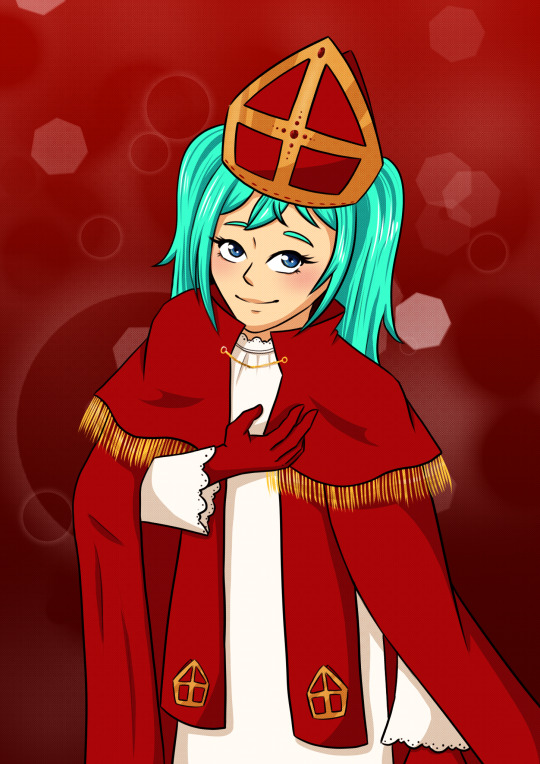
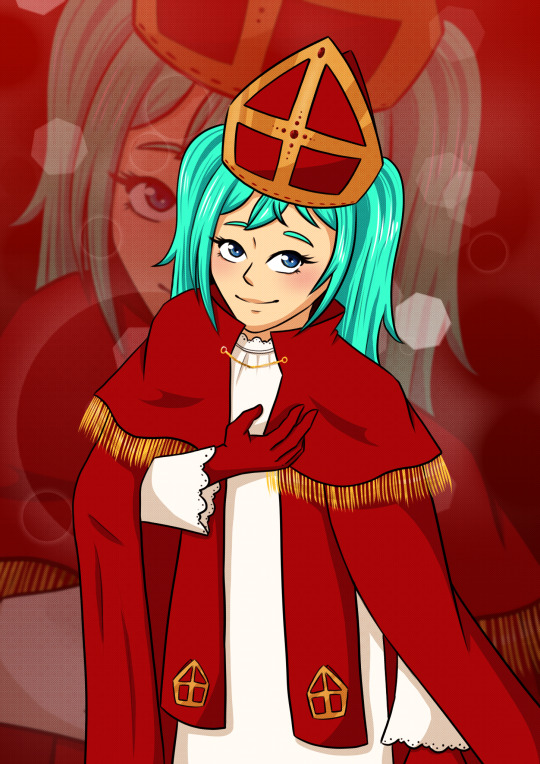
Redraw of something I did in 2019. This one's for my fellow Belgians and the dutchies
121 notes
·
View notes
Text

Hoofdpoekie 🩷
Bro heeft alles onder controle
#hoofdpiet#het sinterklaasjournaal#sinterklaasjournaal#sinterklaas#sintposting#niels van der laan#dutchblr#nederblr#fanart#original art#digital art#artists on tumblr#sinterklaasjournaal fan art
82 notes
·
View notes
Text

"In Sinterklaas Parkour Civilisatie springt niemand voor de speculaaspop. Het is veiliger om voor de pepernoot te springen."
#te niche?#het pietenhuis is wat verbouwd jongens#hoofdpiet is natuurlijk de parkour kampioen#sinterklaas is de parkour god#mod weaboopiet#sinterklaasjournaal#sinterklaas
67 notes
·
View notes
Note
Favoriet sinterklaassnoep
Pepernoten (die ronde)
Pepernoten (die vierkante)
Chocolade pepernoten
Schuimpjes
Borstplaat
Marsepein
Speculaas
Chocolade munten
40 notes
·
View notes
Text
The History of Santa Claus
Santa Claus—otherwise known as Saint Nicholas or Kris Kringle—has a long history steeped in Christmas traditions. Today, he is thought of mainly as the jolly man in red who brings toys to good girls and boys on Christmas Eve, but his story stretches all the way back to the 3rd century, when Saint Nicholas walked the earth and became the patron saint of children.
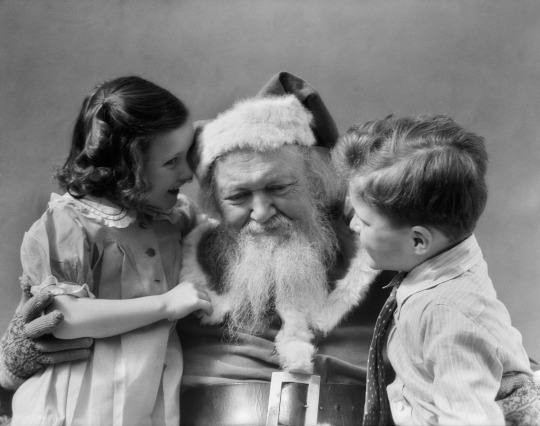
Santa Claus wasn't always "chubby and plump, a right jolly old elf." PHOTOGRAPH BY CLASSICSTOCK/CORBIS
The Legend of Saint Nicholas
The legend of Santa Claus can be traced back hundreds of years to a monk named St. Nicholas. It is believed that Nicholas was born sometime around A.D. 280 in Patara, near Myra in modern-day Turkey. Much admired for his piety and kindness, St. Nicholas became the subject of many legends.
One of the best-known St. Nicholas stories is the time three young girls are saved from a life of prostitution when young Bishop Nicholas secretly delivers three bags of gold to their indebted father, which can be used for their dowries. He was very religious from an early age and devoted his life entirely to Christianity. The strict saint took on some aspects of earlier European deities, like the Roman Saturn or the Norse Odin, who appeared as white-bearded men and had magical powers like flight. He also ensured that kids toed the line by saying their prayers and practicing good behavior. In continental Europe (more precisely the Netherlands, Belgium, Austria, the Czech Republic and Germany), he is usually portrayed as a bearded bishop in canonical robes.
During the Middle Ages, often on the evening before the anniversary of his death, December 6, children were bestowed gifts in his honour. By the Renaissance, St. Nicholas was the most popular saint in Europe. Even after the Protestant Reformation, when the veneration of saints began to be discouraged, St. Nicholas maintained a positive reputation, especially in the Netherlands.
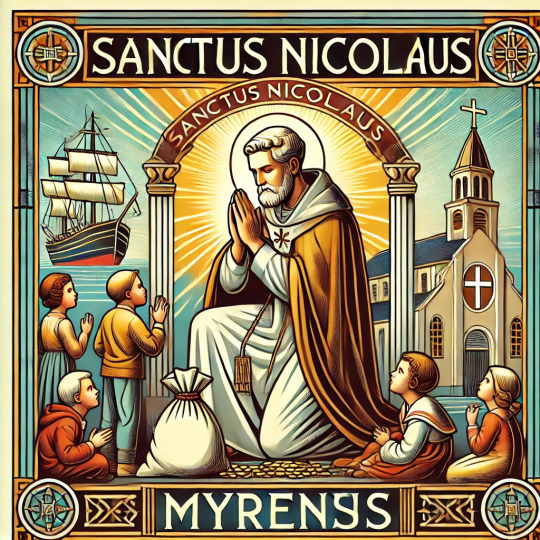
Coming to America
In the Netherlands, kids and families simply refused to give up St. Nicholas, or Sinterklaas as the saint is called in Dutch, as a gift bringer. They brought Sinterklaas with them to New World colonies. St. Nicholas made his first inroads into American popular culture towards the end of the 18th century. In December 1773, and again in 1774, a New York newspaper reported that groups of Dutch families had gathered to honor the anniversary of his death.
The name Santa Claus evolved from Nick’s Dutch nickname, Sinter Klaas, a shortened form of Sint Nikolaas (Dutch for Saint Nicholas). In 1809, Washington Irving helped to popularize the Sinter Klaas stories when he referred to St. Nicholas as the patron saint of New York in his book, The History of New York. As his prominence grew, Sinter Klaas was described as everything from a “rascal” with a blue three-cornered hat, red waistcoat, and yellow stockings to a man wearing a broad-brimmed hat and a “huge pair of Flemish trunk hose.” An appearance that was more derived from the English 'Father Christmas' and was quite different from the Dutch Sinterklaas.
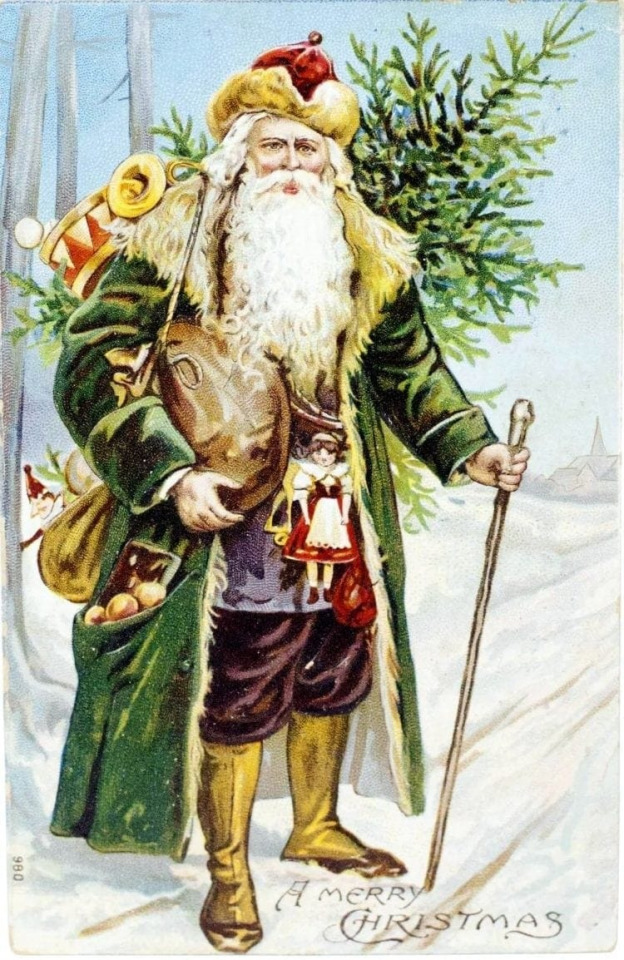
Santa Equivalents Around The World
Eighteenth-century America’s Santa Claus was not the only St. Nicholas-inspired gift-giver to make an appearance at Christmastime. There are similar figures and Christmas traditions around the world.
The English legend explains that Father Christmas visits each home on Christmas Eve to fill children’s stockings with holiday treats. Father Christmas dates back as far as 16th century in England during the reign of Henry VIII, when he was pictured as a large man in green or scarlet robes lined with fur. He typified the spirit of good cheer at Christmas, bringing peace, joy, good food and wine and revelry. As England no longer kept the feast day of Saint Nicholas on 6 December, the Father Christmas celebration was moved to 25 December to coincide with Christmas Day.
In the Netherlands and Belgium, the character of Santa Claus competes with that of Sinterklaas, based on Saint Nicholas. Santa Claus is known as de Kerstman in Dutch ("the Christmas man") and Père Noël ("Father Christmas") in French. For children in the Netherlands, Sinterklaas still remains the predominant gift-giver in December mostly celebrated on Sinterklaas evening the day before 6 December.

In Germany, the Christmas season is marked by the presence of two significant figures: Weihnachtsmann and Das Christkind or Christkind'l. Weihnachtsmann, a term that literally translates to "Christmas Man," is the German counterpart to Santa Claus. In contrast, Das Christkind, meaning "The Christ Child," represents a more traditional and religious aspect of German Christmas celebrations. Christkind was believed to deliver presents to well-behaved Swiss and German children on Christmas Eve. The name "Kris Kringle", a common variant of Santa in parts of the United States is derived from Christkind.
In Nordic folklore, the figure known as Tomte or Jultomten holds a special place in Christmas traditions. Originating from Swedish and Scandinavian mythology, Tomte is a small, mythical creature often depicted as a friendly, bearded being resembling a garden gnome and wearing a red cap. During the Christmas season, Tomte takes on a role similar to that of Santa Claus, delivering presents to children in a sleigh drawn by goats on the night of December 24th.
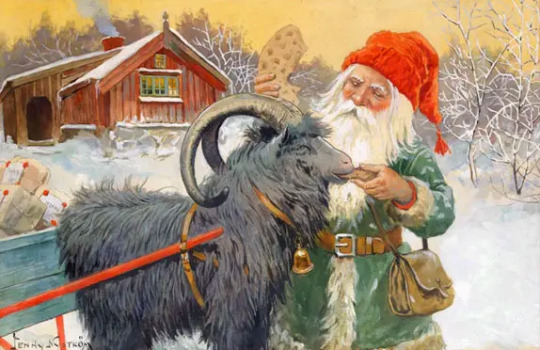
In Icelandic folklore, the Yule Lads, or "Jólasveinar," are mischievous characters associated with the Christmas season. These thirteen brothers, sons of the mountain-dwelling trolls Grýla and Leppalúði, are known for their playful antics and sometimes slightly sinister behavior. Traditionally, the Yule Lads would visit homes in the thirteen nights leading up to Christmas, each leaving small gifts or playing pranks depending on the behavior of the children.
In Italy, the Christmas season is marked by the presence of two iconic figures: Babbo Natale and La Befana. Babbo Natale, the Italian counterpart to Santa Claus, shares many similarities with the global image of the jolly gift-bringer. The other Italian icon, La Befana, is a unique and beloved figure in Italian folklore. Unlike the festive and plump Babbo Natale, La Befana is portrayed as an old woman, often depicted as a haggard but kind witch. According to tradition, La Befana visits homes on the night of January 5th, leaving small gifts and sweets for children who have been good and a lump of coal for those who have been naughty.
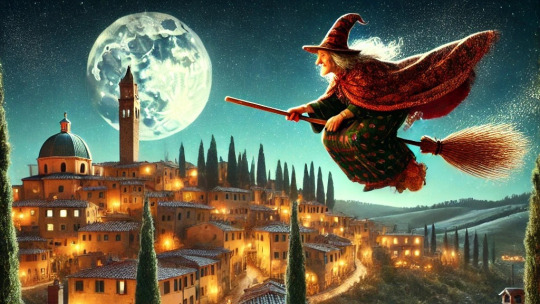
In French-speaking regions, the iconic figure associated with Christmas gift-giving is Père Noël, also known as Papa Noël. Père Noël is akin to the global representation of Santa Claus, often depicted as a jolly and benevolent character who travels in a sleigh pulled by reindeer, embodying the spirit of generosity and joy during the festive season.
In Spain and many Spanish-speaking cultures, the Christmas season unfolds with the anticipation of visits from both Papa Noel and Los Reyes Magos, offering children a delightful blend of traditions. Papa Noel, the Spanish equivalent of Santa Claus, is eagerly awaited on the night of December 24th. Following this, the celebration continues with the arrival of three kings known as “Los Reyes Magos” on January 6th. This holiday is known as Three Kings' Day or Día de Reyes. On the night before Día de Reyes, children place their shoes or small containers filled with hay under their beds for the Kings' camels. In return, Los Reyes Magos leave gifts, sweets, and small toys, creating a magical and cherished experience for children who wake up to the joyous surprises.
In Russia, instead of Santa, there is Ded Moroz and his granddaughter Snegurochka, who deliver gifts to children on New Year’s Eve. Children would sing Russian songs around the yolka.” A yolka is a coniferous tree similar to a Christmas tree. Ded Moroz is described as a grandfather with a long white beard.
Mikuláš (also known as Saint Nicholas) is the father of Christmas in the Czech Republic, as well as in Hungary. Mikuláš looks like the Pope and Santa combined. However Mikuláš is not always the person delivering presents on Saint Nicholas Day, it is typically believed to be Jesus. Saint Nicholas Day in the Czech Republic is predominantly celebrated on Dec. 5-6, although depending on the region, it is also celebrated on Dec. 25. Children put a boot out on the eve of Saint Nicholas Day and hope to find it full of candy and toys from Jesus in the morning. Bad kids can expect only a wooden spoon in their shoe.
In Japan Hoteiosho, or Hotei, is the equivalent of Santa pictured as a fat man with eyes in the back of his head who can tell if kids are naughty or nice. He is also known as the “Laughing Buddha,” because he is often depicted with a jovial face and surrounded by grinning children. Hotei is one of the Seven Lucky Gods, stemming from ancient Chinese and Indian religion. Hotei may have been based on a real person, named Budai, a man who died in 916 A.D. and was later worshipped in Buddhist practice.
So far a selection of customs and traditions similar to Santa Claus. Of course there are more, and in many traditions parallels to other cultures can be found.

sources; history.com, nationalgeographic.com, wikipedia
#santa claus#saint nicholas#kris kringle#sinterklaas#father christmas#pere noel#papa noel#history#jultomten#christmas eve#december 6#december 24#yule lads#weihnachtsmann#christkindl
31 notes
·
View notes
Text
As we approach Yule and the winter holidays, we see a LOT of false narratives around the origins of the ways in which they're celebrated. And not in the ways you think. This blog lays out sources intelligently and logically to illustrate the facts of our human history, not false sentiments of anti-Christianity/Pagan superiority.
I particularly appreciated this quote in their conclusion: "[I]t’s easy enough to show that the claims are wrong and then in turn that makes it look like Pagans and NeoPagans trade in propaganda, conspiracy theories, and uneducated claims - it makes all of us look bad. But to me, more importantly, when someone is starting out and wants to learn, misinformation builds walls, hurdles, and snares that they won’t know how to navigate at the start of their journey."
So before we go around teaching ourselves and others false information upon which to build our practices and worldviews, let's take the time to educate ourselves, yeah? I admit I have yet to get through *every* source listed in this blog as there are many (I am working on it, though!). I just believe this is vital information and have no desire to wait to share it.
Knowing what we celebrate, how we do it, and the why of it all is important, no matter the origins. Embracing our history and our modern practices need not be mutually exclusive. I hope this information strengthens and blesses your winter practices and celebrations this year. 🌟
#winter holidays#history#yule#jol#saturnalia#christmas#christmas trees#santa claus#sinterklaas#christmas traditions#holiday traditions#pagan traditions#religious history#religion#pagan#paganism#neopagan#neopaganism#historical accuracy#important#christianity#resources#academic research#academic#academia#informative#modern paganism#misinformation
47 notes
·
View notes
Text
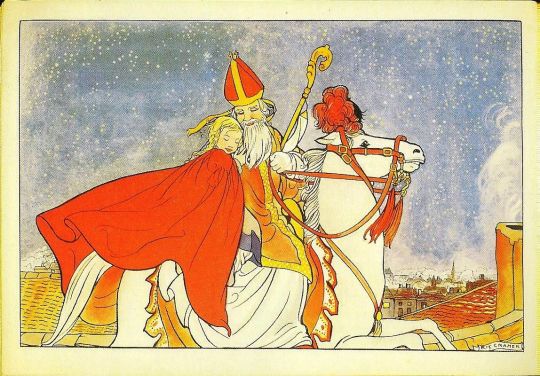
Illustratie uit Het land van Sinterklaas by Rie Cramer
#isn't this the sweetest most heart-warming!#for his arrival.... :')#sinterklaas#saint nicholas#rie cramer#vintage#childrens illustration#the netherlands#dutch culture
155 notes
·
View notes
Text
23 notes
·
View notes
Text

#I realize that the overlap between people who are on tumblr and people who still watch het sinterklaasjournaal is probably incredibly small#but I needed to release this into the wild#sinterklaas#sinterklaasjournaal#destiel meme#Merel westrik
28 notes
·
View notes
Text
Are chocolate letters something outside of the Netherlands? Here, we celebrate Sinterklaas (sort of Santa Claus), and you can get a letter made of chocolate. They are on sale in every flavor and every letter you want, so most people get the fist letter of their name in their favourite flavour.

Because if it is, Remus would definitely get one of all his friends, and Sirius decides one day to give him the whole ‘Remus John Lupin’.
#Sinterklaas#christmas#santa#santa claus#chocolade letter#chocolate letters#chocolate letter#chocolate#Remus lupin#Remus John lupin#remus loves chocolate#marauders#the marauders#marauders era#the marauders era
24 notes
·
View notes
Note
What are Mr and Mrs Nick opinions on Krampus' punishing people by changing them into toys? Are they okey with that? Do they even have opinions about that? Or do they treat it as his hobby/job?
... Do they advice him sometimes?
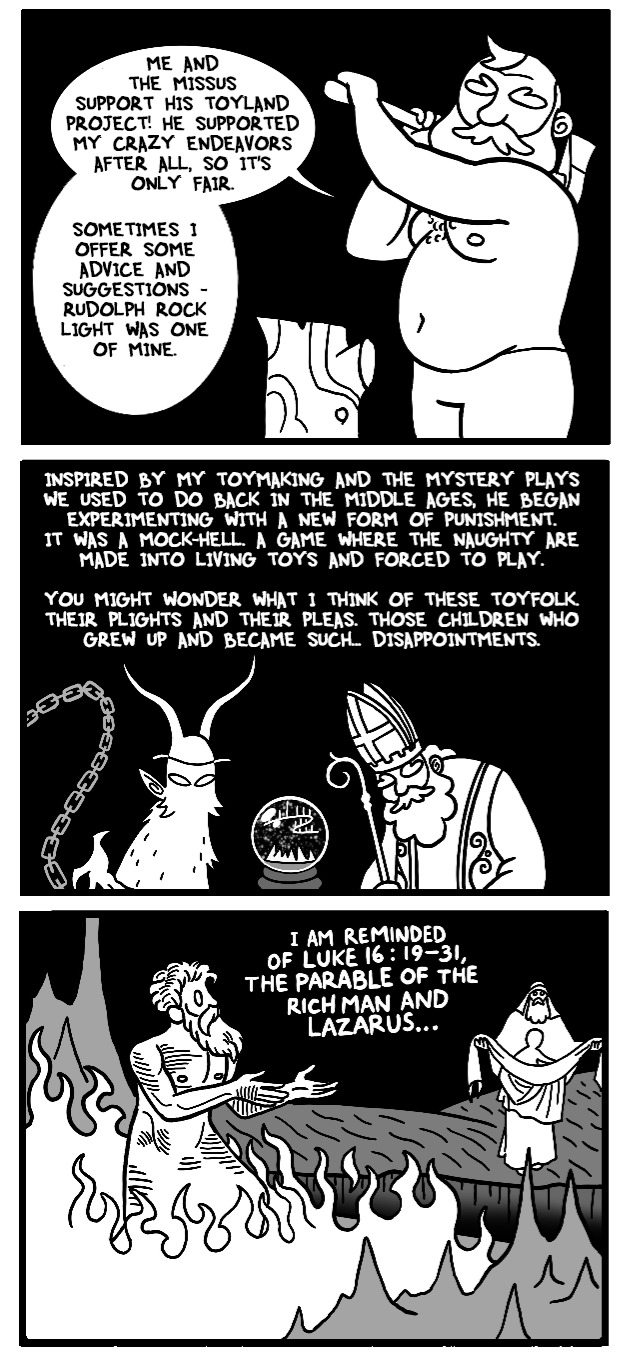
#ask#misfits in toyland#tales of the otherfolk#santa claus#saint nicholas#st nick#krampus#my art#lore#comic#christianity#sinterklaas#my characters#bible
78 notes
·
View notes
Text
Sinterklaasjournaal is echt nog unhingeder dan normaal dit jaar
23 notes
·
View notes
